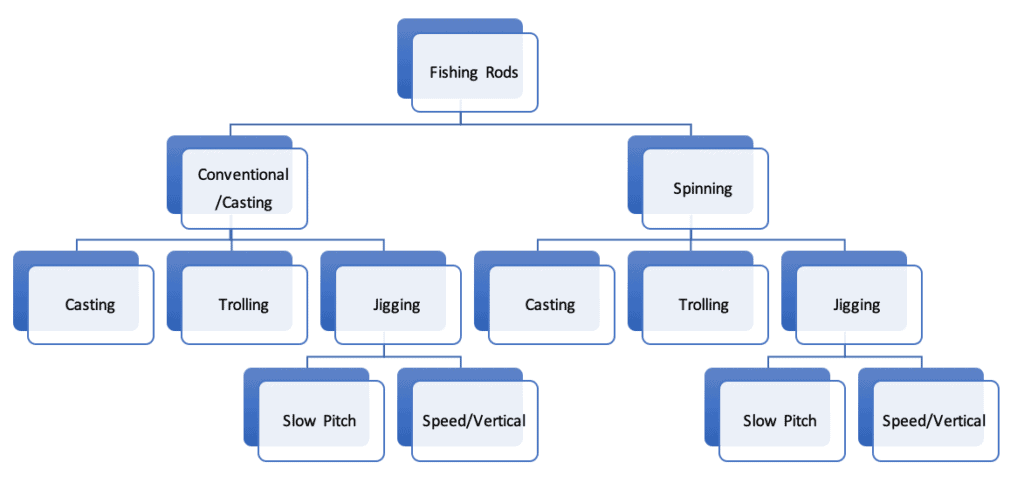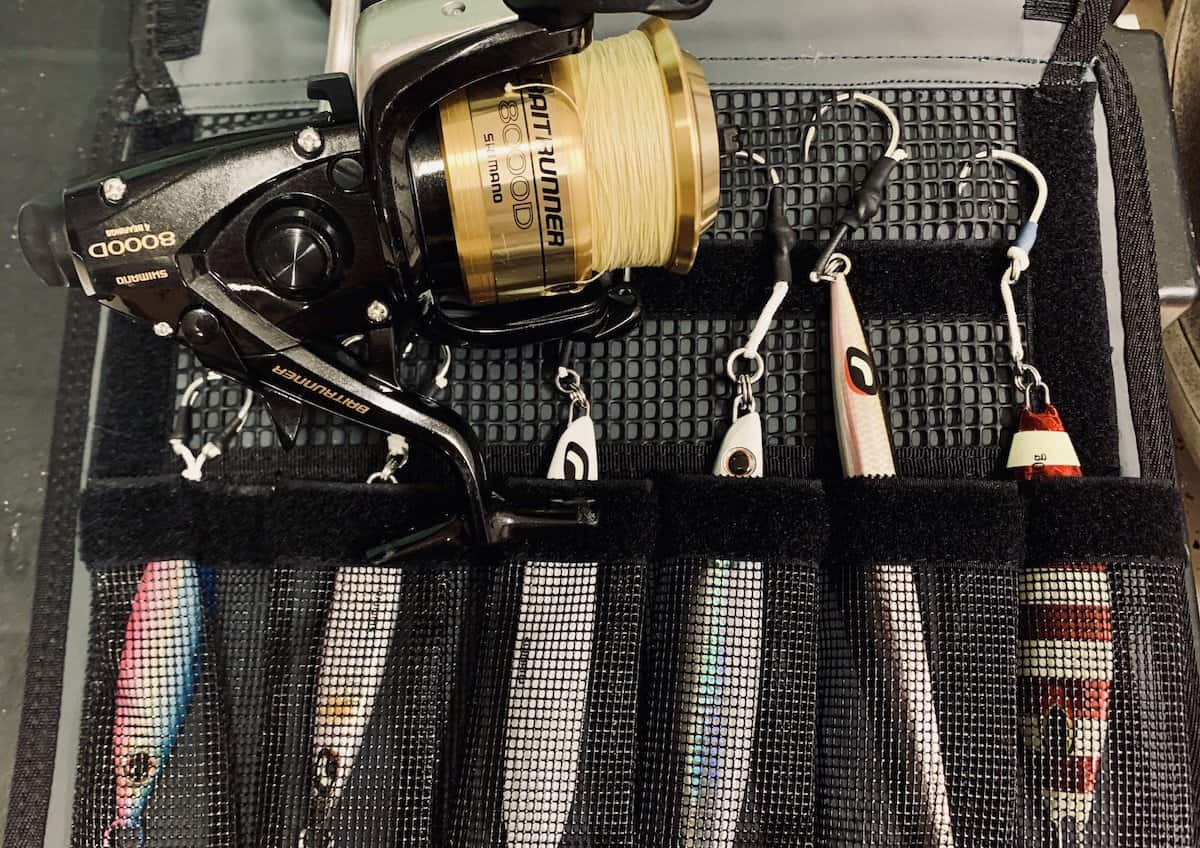Many fishermen prefer to use spinning tackle over conventional tackle, and there are many good reasons for it. Spinning reels are easier to use. When a mistake is made with conventional reels, like not using enough thumb pressure during a cast, anglers can spend the next 15 minutes undoing a bird’s nest. Spinning reels can get bird’s nests, but its far less frequent and usually occurs because of too much line on the reel. For most of us, spending a day offshore fishing doesn’t happen too often, so spending time getting your line untangled can really be a drag (pun intended, ha). Conventional jigging reels also require the angler to manually levelwind during the retrieve. Getting the hang of a jigging technique and rhythm is usually already a challenge, so making sure the line lays evenly on the spool can further complicate it.
There is also the reality that some anglers fish too infrequently to warrant spending the amount of money needed to have gear that’s perfectly suited for the type of fishing you’re doing. Many anglers would prefer to try out a new technique with a setup they already have, instead of spending a few hundred dollars on another one. If you already have an appropriate sized spinning reel that you cast with, you can simply buy a jigging rod and move the reel from one rod to the other when changing techniques. Most anglers have a spinning setup already, so using spinning for jigging can be great when you’re on a budget. Its also very common to meet anglers who prefer to use spinning reels, simply because they feel its more comfortable.
Slow jigging, speed jigging, and vertical jigging can all be done with a spinning reel or a conventional reel. Unlike conventional setups, spinning reels are located on the underside of the rod, and the rod guides are on the underside. When jig fishing with spinning tackle, be sure not to lean the rod on the gunwale for extra leverage—it’ll pin your line against the rod and cause excessive abrasion to both the rod and line. Spinning rods and reels can be found in sizes with similar line capacity and weights for comparable overhead tackle. Jigging with spinning tackle can give you the versatility to do jigging and casting with the same reel, which can help if you have a limited budget. Spinning rods and reels can also be a great choice for new anglers since they tend to be more forgiving when mistakes are made.
Can A Spinning Rod & Reel Be Used for Slow Pitch Jigging?
Slow pitch jigging is done by initially letting a slow jig fall in freespool all the way to the bottom. The jig is balanced and tapered in such a way that the lure lays horizontally when it falls and wobbles. The slow and wobbly jigs look like a dying baitfish to predators. Although this method of jigging is most commonly done with a conventional reel, spinning rods and reels can still be used to do the technique. Choosing the right spinning reel comes down to the specs. You’ll need to have enough line capacity, fast retrieve rate, and a light weight to fight fatigue. Line capacity is critical to ensure you can reach the bottom with a spinning reel for slow pitch jigging. A fast retrieve rate is needed to rid the line of slack and maintain control of the jig. Slow pitch jigging is a repetitive motion that causes fatigue after a while, so the lighter the weight, the better.
When jigging, you’re going to be letting your jig fall to the bottom and then jigging it back up. You’ll need to make sure your reel has enough line capacity for the depth you’re targeting. I usually shoot for having 100 yards of line on the reel after I’ve reached my target depth. The size 2000 overhead Ocea Jigger conventional reel holds 340 yards of 50 lb test and the comparable spinning alternative, Shimano Twin Power SW 10000, holds 360 yards of 50 lb test. As long as you choose the correct size reel, both a conventional and spinning reel can get you the capacity you need.
The retrieve rate is also a key feature when jigging. Slow pitch jigging requires a fast retrieve rate to ensure the slack line can quickly be removed. The table below shows a comparison of several specs for the Shimano Ocea Jigger 2000 conventional reel and the Shimano Twin Power SW 10000 spinning reel. Among the specs listed, you can see the retrieve rates are similar. 40+ inches per turn will be enough to get the slack out of your line, even when fishing in strong currents with heavy jigs.
The table below also compares the weight of two similarly sized reels, one conventional and one spinning, that can be used for jigging. The Ocea Jigger 2000 size is 21 ounces and the spinning reel is 23.1 oz. The difference of 2.1 ounces is a low cost to pay for a single spinning reel that can also throw topwaters to tuna at first light. To maximize the sensitivity of your setup, you’ll need to spool your reel with braided line. To read more about why braid is best for jigging, read my article Is Braid or Mono Best for Jigging? And What Pound Test?
| Model | Spin/ Conv | Weight [oz] | Gear Ratio | Retrieve Rate [IPT] | PowerPro Braid Capacity [lb/yds] | Max Drag [lb] | Price |
| Ocea Jigger 2000 High Gear (slow pitch jigging) OCEAJG2000NRHG | Conv | 21 | 6.2:1 | 46 | 50/340 | 22 | $550 |
| Twin Power SW 10000 TPSW10000XGC | Spin | 23.1 | 4.9:1 | 40 | 50/360 | 55 | $680 |
What’s The Difference Between a Jigging Rod and a Spinning Rod?
A spinning rod is a rod in which the guides are mounted on the underside of the rod, and the diameter of the guide closest to the reel is large. The large diameter of the guide near the reel allows the cone of line to come off the reel without forcing it to go through a dramatic angle right away. A spinning rod can be almost any length—the longest lengths meant for casting long distances and the shortest lengths designed for trolling or jigging. A common question among new anglers is what is the difference between a jigging rod and a spinning rod?
Jigging rods and spinning rods are not at the same level of hierarchy in fishing rod categories, see the figure below. At the top of the hierarchy are conventional or spinning rods. Conventional rods have guides mounted on top and the guides closer to the reel are smaller in diameter when compared to a spinning rod because the guide doesn’t need to accommodate a cone of line. Spinning rods have guides mounted on the underside and the guide closest to the reel is usually quite large in diameter to accommodate the spiral cone of line as it comes off the spool. A jigging reel can be either conventional or spinning, it depends on which style of reel the angler prefers to use.
Jigging rods are usually short, around 6 ft or so, to give the angler better control over the jig. It can be challenging to work a jig properly if the rod is sticking out too far from the boat. The shorter rods also give the angler more leverage at the end of the fight, right when its needed most.
Speed, or vertical, jigging rods are usually fast action. The fast action is critical for hooksetting when speed jigging. The strikes are usually hard and the rod needs to get to the backbone quickly to withstand the fight. They’re usually heavy power (or stronger) to fight back against hard fighting fish. Speed jigging rods is a heavy tackle technique, so you’ll see heavier line rating and heavier powers on speed jigging rods. A great speed jigging rod is the Shimano Trevala PX which is available in spinning or casting options. Slow pitch jigging rods are usually moderate to slow action to give the rod a nice parabolic bend to perform the rhythmic motions. Slow pitch jigging is a light tackle technique and you’ll see light line ratings and lighter power for these rods. A great slow pitch jigging rod is the Ocean Tackle International Pitch Black Slow Pitch Jigging rod which is also available in both spinning or conventional options.

Do You Need a Special Rod for Jigging?
A jigging setup is not complete without considering the rod pairing. Slow pitch jigging and speed jigging are special techniques requiring the use of special rods. Both types of jigging are done with the butt end of the rod underneath the angler’s armpit. A split grip butt is best to give the most comfort in the position and also to make sure the rod’s action is seen all the way through the butt section. Slow pitch jigging requires a moderate to slow action for a parabolic bend, and speed jigging requires a fast action to swiftly set the hook with strong biting fish. The length of a jigging rod is normally around 6 ft to give you just enough length to get over the edge of the boat. The lure rating of the rod must also be matched to the chosen jig.
If you plan to do both speed jigging and slow pitch jigging with the same reel, you’ll need a rod that will work well for both techniques. The Shimano Game Type J has moderate fast action and an appropriate power for the lure rating. It’s also extremely lightweight to fight fatigue and has Spiral X technology to prevent the rod from twisting to the side in a fight.
In general, the heavier the rod power, the higher the lure rating. And as a rule of thumb, you’ll need about 100 grams of lure per every 100 feet of depth. If you plan on fishing in 200 feet of water at an offshore reef, you’ll need to get a rod that can handle at least 200 grams, but not so heavy that you can’t effectively work your jig with your rod. The lure rating you purchase will depend on where you see yourself most frequently fishing. If you spend most of your time under 250 feet of depth, which would mean 250 gram lure or less, a lure rating or 250 grams would be great. Shimano has a great line of Butterfly jigs, some of which are speed jigs and some are slow jigs, and I reviewed them in my article, here.
The table below compares a spinning and a conventional version of the Shimano Game Type J jigging rod. Notice the difference in foregrip and reargrip lengths. These lengths differ because of the shape and structure of each type of reel, but both will put your reel in a comfortable location in front of you. Regardless of whether you choose to jig with a spinning reel or conventional reel, the Shimano Game Type J has a rod that will work for you.
| Model | Spin/Conv | Length | Power | Action | Braid Rating | Lure Rating | Foregrip length | Reargrip length |
| Game Type J GTJS510MHA | Spin | 5’10” | MH | Mod-Fast | 50 lb | 250g | 2.3in | 13in |
| Game Type J GTJC60MHA | Conv | 6’ | MH | Mod-Fast | 50lb | 250g | 1.3 | 15in |
I hope this article helps you understand that spinning tackle can definitely be used for jig fishing. If you’re still deciding about conventional or spinning tackle for slow pitch jigging, read my article How I Chose My Slow Pitch Rod, Reel, & Jigs. Tight lines y’all!

